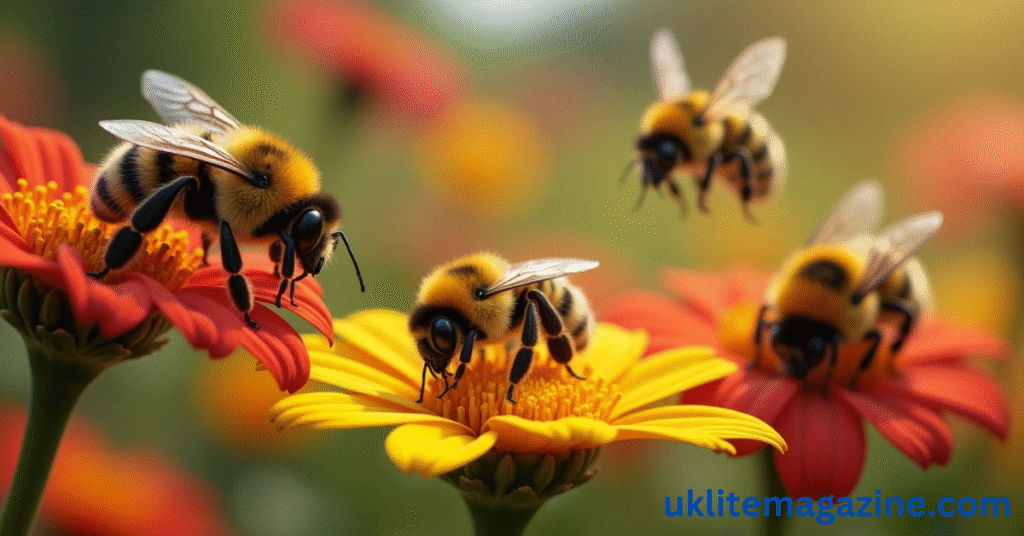Bees are more than just honey makers. They play a key role in pollination and keeping our ecosystems healthy. But did you know there are over 20,000 different types of bees in the world? Each species has unique traits, roles, and behaviors that make them fascinating. In this article, we’ll explore the most common types of bees and what sets each one apart.
Why Are There So Many Types of Bees?
Bees have evolved to adapt to different environments, flowers, and climates. Some live in large colonies, while others prefer a solitary life. Some make honey, and others don’t. These differences help bees survive and pollinate a wide range of plants, which benefits the entire planet.
Common Types of Bees and What Makes Them Unique
Here’s a breakdown of the most well-known bee species and their special features:
| Type of Bee | Main Characteristics | Sting? | Lives in Colonies? |
|---|---|---|---|
| Honeybee | Produces honey, lives in large colonies, led by a queen bee | Yes (rarely stings) | Yes |
| Bumblebee | Larger and fuzzier than honeybees, excellent pollinators, active in cooler weather | Yes | Yes |
| Carpenter Bee | Digs tunnels into wood, solitary, often mistaken for bumblebees | Yes (females only) | No |
| Mason Bee | Uses mud to build nests, very gentle, amazing pollinators | Rarely | No |
| Leafcutter Bee | Cuts leaves to build nests, solitary, efficient pollinator | Rarely | No |
| Sweat Bee | Attracted to human sweat, tiny and metallic in color, important pollinators | Mild sting | No |
| Queen Bee | Only one per colony, lays eggs, central to the hive’s survival | Yes | Yes (in honeybee/bumblebee colonies) |
Honeybee: The Famous Worker
Honeybees are the most well-known type of bee. They live in colonies with a complex social structure. One queen bee lays all the eggs, while worker bees collect nectar, make honey, and care for the young. Drones (male bees) only exist to mate with the queen. Honeybees are also widely used in farming to pollinate crops like apples, almonds, and blueberries.
Bumblebee: The Fuzzy Giant
Bumblebees are bigger and fuzzier than honeybees. They’re strong pollinators and can even “buzz pollinate,” which shakes loose pollen from flowers. They’re especially helpful in colder climates where honeybees may not survive.
Carpenter Bee: Nature’s Woodworker
Carpenter bees get their name from their habit of drilling tunnels into wood to lay eggs. Unlike termites, they don’t eat the wood—they just make a home inside it. Males are often seen hovering around but don’t sting. Only the female carpenter bee can sting, and she rarely does.
Mason Bee: The Gentle Pollinator
Mason bees are named after the way they use mud or clay to seal their nests. These solitary bees are incredibly gentle and excellent at pollination. One mason bee can pollinate as many flowers as 100 honeybees!
Leafcutter Bee: The Garden Artist
Leafcutter bees snip round pieces from leaves to build their nests. This might look like plant damage, but it’s rarely harmful. These bees are efficient pollinators and very gentle, making them a gardener’s friend.
Sweat Bee: Small but Mighty
Sweat bees are small, often metallic-looking, and are drawn to human sweat. Their sting is mild and rare. Despite their size, they are strong pollinators found throughout the world.
Queen Bee: The Heart of the Hive
The queen bee is the most important member of a colony. She’s responsible for laying eggs and producing pheromones that keep the colony functioning smoothly. She is the mother of all bees in her hive.
Conclusion
Understanding the different types of bees helps us appreciate their role in nature. From honey-makers to silent pollinators, every bee species contributes in its own way. Protecting bees isn’t just about saving honeybees—it’s about safeguarding the entire ecosystem.
Frequently Asked Questions (FAQs)
What are the 3 main bees?
The three main bees in a colony are:
-
Queen Bee: Lays eggs and leads the colony.
-
Worker Bee: Female bees that collect food, care for larvae, and maintain the hive.
-
Drone Bee: Male bees that mate with the queen and don’t perform other tasks.
What kind of bee doesn’t sting?
Most male bees, including drone honeybees and male carpenter bees, do not have stingers and cannot sting. Solitary bees like mason bees and leafcutter bees rarely sting and are very docile.
What is the main type of bee?
The most commonly known and widely used bee is the honeybee. It’s the main bee used for pollination and honey production.
Which bee is female?
Both the queen bee and worker bees are female. Only females have stingers and perform tasks within the hive or in the field.
How is a queen bee born?
A queen bee is born from a fertilized egg like a worker bee, but she is fed a special diet called royal jelly throughout her development. This rich food triggers her transformation into a queen.

